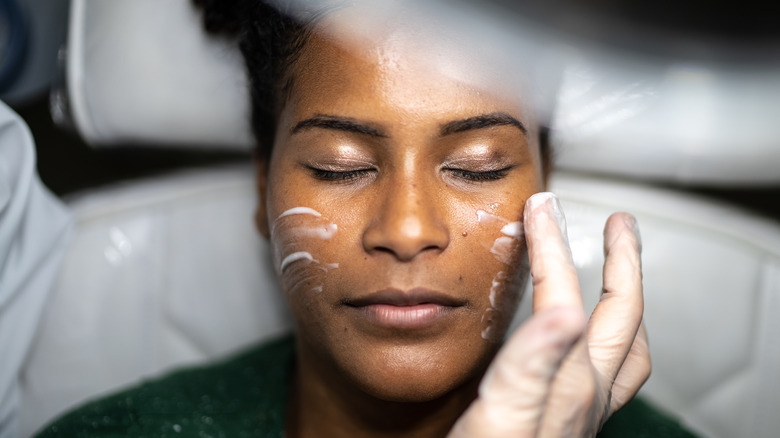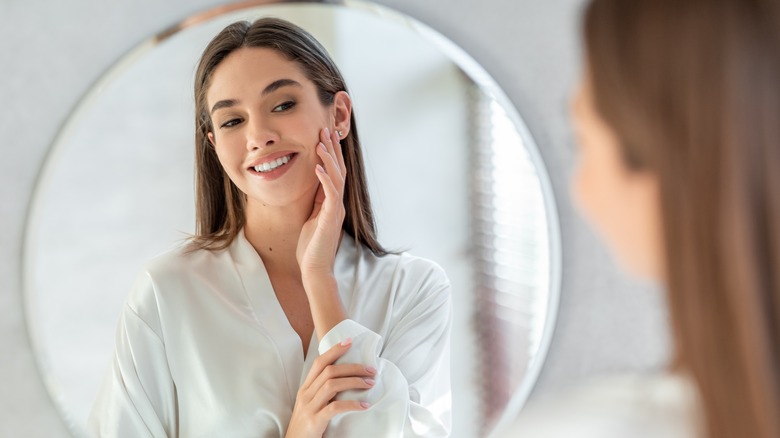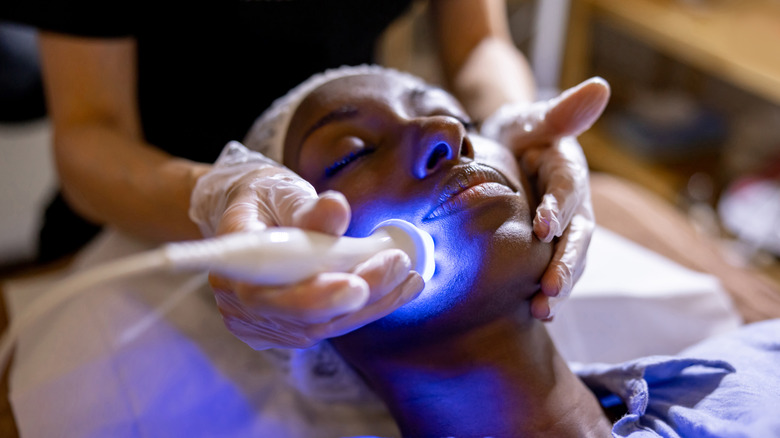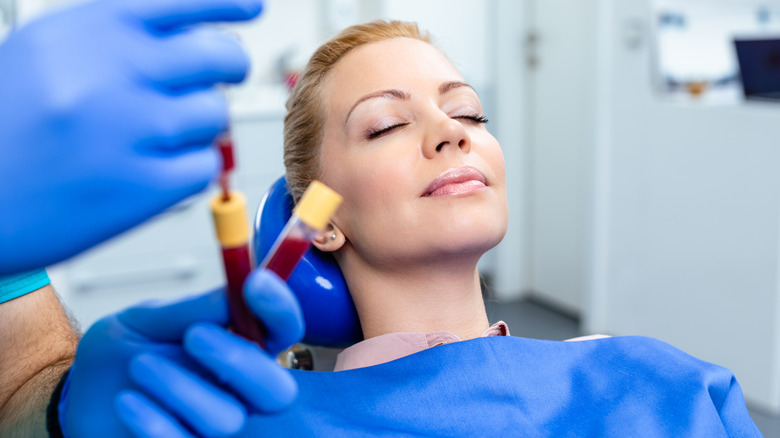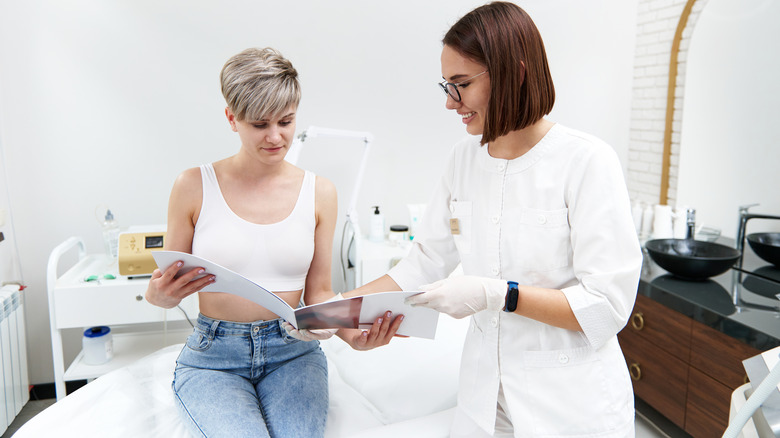Exosomes: What To Know About The Science Behind The Emerging Skincare Therapy
Skincare fans know that caring for their complexions is more than skin deep. There's a lot of science taking place behind the scenes when you apply a serum with actives or take a supplement to combat skin health issues. For those who don't mind a bit more intermediate-level science — think your Biology 201 class in high school — exosomes are worth studying. Essentially, exosomes are nano-sized cell components believed to keep cells healthy while acting as little message carriers. "They work by communicating and transmitting signals between cells," board-certified dermatologist Ramya Garlapati explained to Glamour. "You can think of them as messengers sending signals to unhealthy cells, triggering them to regenerate." For your skin, this could mean faster healing and a plumper, more radiant complexion.
Skincare exosomes found in the U.S. and South Korea are typically sourced from actual human stem cells via umbilical cords, bone marrow, and fat. However, countries where human matter can't legally be used, such as the U.K. and those in the European Union, source exosomes from plant cells instead.
If exosomes sound like just another trendy ingredient, albeit with an extra sciencey twist, think again. Some skin experts say there's almost nothing these cell particles can't do.
The benefits of exosomes in skincare
Most skincare ingredients on the market promise to tackle one or two concerns, such as acne scars or fine lines. Exosomes, on the other hand, kind of do it all. "They are like a troubleshooter," Dev Patel, a specialist in aesthetics and regenerative medicine and medical director of the Perfect Skin Solutions Clinic, told the Evening Standard. "You don't have to have a specific skin indication to use them as they will signal pretty much everything. It could just be pigmentation and open pores, or it could be loss of elasticity." Dermatologist Ramya Garlapati agrees, citing to Glamour its many potential benefits including diminishing acne scars, revitalizing a dull complexion, minimizing enlarged pores, and reducing pigmentation.
More research is needed to uncover just how exosomes impact and revitalize the skin, though one 2021 research review published in the journal Biomaterials Research concluded that the particles are effective at forming new blood vessels, managing inflammation, and promoting collagen production. Specifically, regenerative aesthetic physician Shameema Damree revealed to Get The Gloss that exosomes work to "produce up to 600[%] more collagen and 300[%] more elastin" once they're absorbed into the skin.
For best absorption, pair with another treatment
If you're new to using exosomes, you may be surprised to learn that treatments containing them rarely come by themselves — often, aestheticians and doctors offer exosome therapy after another in-office procedure that creates channels in the skin, such as microneedling or lasering. "These channels allow the exosomes to be absorbed and reach the deeper skin layers for enhanced rejuvenation," Eunice Park, a dual board-certified facial plastic and reconstructive surgeon, explained to Glamour. Otherwise, the exosomes risk simply sitting on top of the epidermis, where they can't properly work their magic.
Another reason to use exosomes with more invasive treatments is that they may offer some much-needed relief. Dermatologist Marina Peredo told NewBeauty that she uses a serum containing exosomes right after microneedling or lasering, which helps mitigate discomfort. "It relieves the burning sensation, reduces redness, and dramatically reduces downtime and inflammation. It can reduce the downtime associated with [energy-based] devices by 80[%]," Peredo added.
Keep in mind that, on their own, microneedling and lasering can cause side effects and irritation. Microneedling might not be suitable for people with blood disorders, acne, or sensitive skin conditions such as psoriasis, while those with acne, dark skin, and extensive wrinkling or sagging should avoid laser skin resurfacing.
Over-the-counter creams are another option
With exosomes making waves in medi-spas and clinics, it was only a matter of time before companies started formulating at-home versions that don't require lasering or needling your face. As Shameema Damree, a regenerative aesthetic physician, told Get The Gloss, "Exosomes' benefits are multiplied when you needle them into skin. However, they can still be beneficial when used as a topical cream, as some of it will penetrate."
Until exosomes become more common, however, there are some downsides to using them in over-the-counter serums and moisturizers. One drawback: the hefty price tag. "Exosome technology is still in its infancy for skin care. There are few high-quality exosome formulas, and those that are available are likely to be more expensive," Dustin Portela, a dermatologist, warned PopSugar. A prime example is Barbara Sturm's Exoso-metic Face Serum, retailing at over $500 for one 30-milliliter bottle.
Then, there are issues with properly packaging and storing exosome-rich formulas. "Exosomes are highly fragile and need to be refrigerated at cold temperatures; they cannot survive for long outside of these conditions," Sanjay Batra, a regenerative medicine expert, shared with The Zoe Report. Therefore, your standard exosome cream won't contain living components, which could impact its efficacy on the skin.
How exosomes compare to PRP
It's hard to talk about exosomes without talking about platelet-rich plasma, "PRP" for short, or, as it's commonly known, the "vampire treatment." PRP — like exosomes — uses cells (specifically platelets) to heal parts of the body. In the case of skin rejuvenation, PRP injections are thought to combat wrinkles and other aesthetic concerns.
While PRP may be more established compared to new-kid-on-the-block exosomes, the latter seems to show greater promise than its predecessor. "[Exosomes are] at least a hundred times more potent than PRP if you use a reputable make of exosomes," regenerative aesthetic physician Shameema Damree claimed to Get The Gloss. Dermatologist Marina Peredo also believes that exosomes are much more foolproof compared to PRP, telling NewBeauty, "Exosomes are 100[%] consistent and contain 10 to 100 times more growth factors than PRP and PRFM [platelet-rich fibrin matrix]." This is because the quality of PRP depends on a person's age and health condition, making them a less reliable choice. "Moreover, exosomes are immediately available and do not necessitate drawing and processing any blood from the patient," Peredo added.
The potential risks of exosome treatments
If you think a new techy skincare trend involving human matter might have some risks, you wouldn't be wrong. Firstly, exosome therapy isn't regulated, as board-certified dermatologist Julie Russak told Marie Claire. In 2019, the U.S. Food & Drug Administration even released a public safety notice warning of the potential dangers of exosome products.
You can protect yourself by learning about how a particular brand or product sources its exosomes. "This includes not only the type of bodily tissue from which they are harvested, but also the country of origin and how the donors are screened to ensure there is no contamination of the biological material," Kristina Kitsos, a registered aesthetic nurse, suggested to Well+Good.
If you don't mind the lack of regulation, the good news is that exosomes themselves are unlikely to cause serious side effects or irritation. "[E]xosomes are generally considered safe and suitable for various skin types – even those with severe sensitivities," Emma Wedgwood, advanced aesthetic nurse and founder of Emma Wedgwood Aesthetics, explained to SheerLuxe. However, Wedgwood recommends checking with a doctor or specialist first before trying the emerging skincare therapy. "Serious risks are rare," she said, "but you should discuss everything with a professional before pursuing the treatment – so make sure you ask any questions and voice any concerns."
